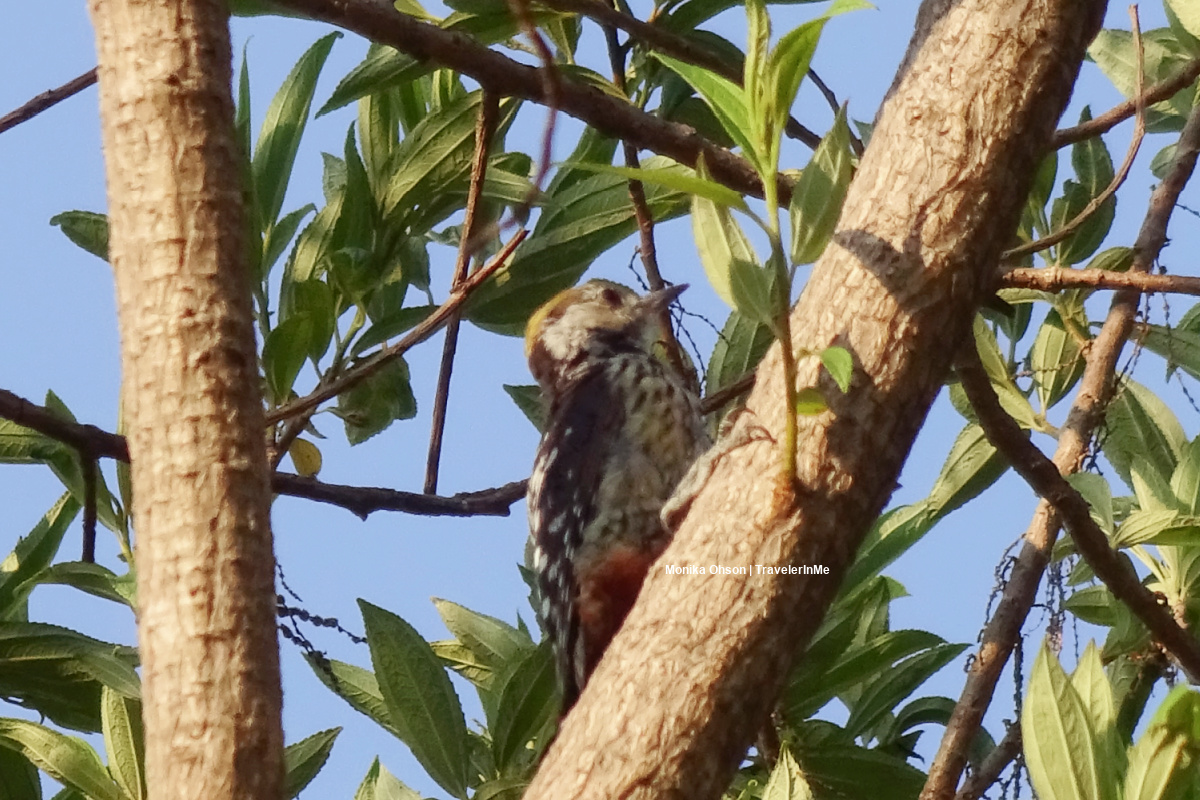.
.

But I still look for those moments of magic where I learn something about life from these beautiful little creatures who grace us with their presence and mesmerize us with their song and dances!
Tweet

Yesterday I came across this vibrant woodpecker near my brother’s home (photo above). Had I not been using my bird watching sense I would have easily missed it. For it was sitting there quietly, at a fantastic height and distance. I was super delighted. I remember photographing it from my home’s balcony. It flew on to the Semal tree silently and my attentiveness made it possible to sight & photograph it. It was there for less than a minute! (photo below)

The Black-Rumped Flameback or Lesser Golden-Backed woodpecker is one of the few woodpeckers that are seen in urban areas.
Did you know? “….Woodpeckers do not drill into trees only to make nests but also to forage for insects and larvae. This way they not only keep the insect population down but also protect trees from pests. In fact, if a woodpecker is drilling into a tree, it could mean that the tree is infested with insects…“

Sharing another woodpecker species that I had come across at my friend’s place in village Bagar Malla, Pangoot. They were high up in the tree and unfortunately I was not carrying the right gears. The Brown-Fronted Woodpecker is mid-sized woodpecker of the Himalayas.

FUN FACTS:
(Googled)
- Woodpeckers’ tongues are usually about twice the length of their bill so that they can reach for insects inside the holes they peck on (up to 4 inches long depending on the species).
- Their nostrils are covered in feathers to keep splinters and dust out while they peck.
- Woodpecker bills help distribute shock throughout the thick skull when pecking.
- In the animal world, woodpeckers are the only creatures to make a sound with something other than a part of its body. They will drum on a variety of objects to communicate territory, to attract mates, to locate food, or maybe even exercise or play.
- When climbing down a tree, they stay upright and lead with the tail first. Other insect-eating tree species of birds, such as nuthatches, crawl down a tree head first.
- Besides insects, woodpeckers also like berries and nuts.
- Woodpeckers create new holes each year, and their old holes are often used by other birds.
- There are more than 180 species of woodpeckers worldwide, and they are adapted to a wide range of habitats.
- The most common plumage colors for all woodpeckers are black, white, red, and yellow.
- Most woodpeckers have zygodactyl feet, which means they have two toes facing the front and two toes facing the back to help them strongly grip trees and poles in a vertical position.

In native spiritual lore the woodpecker carries far more meaning than just being a pretty bird who pecks at trees. It heralds an upcoming change in the life of the person who sees it. The message is that “an opportunity is knocking and it’s up to you to seize the moment“.
Tweet
- In Norse mythology woodpeckers are associated with Thor god of thunder.
- In Roman mythology a woodpecker named Picus is sacred to god Mars. Picus was worshiped and developed into an agricultural deity.
- The Celts believed that the woodpeckers screech is a sign of rain.
- In many Native American Indian tribes woodpeckers are associated with friendship and happiness.
Find your own rhythm;
ADVICE FROM A WOODPECKER
Peck away at obstacles;
Be colorful;
Carve a place for yourself;
Make your voice heard;
It’s OK to be a little flashy;
Use your own head!
Do watch out for the next post on another species from my #BalconyBirdingList
Posts shared so far on:
1. Rosy Starlings
2. Alexandrine Parakeet
3. Rose-Ringed Parakeet
4. Plum Headed Parakeet
5. Indian Spot-Billed Duck
6. Yellow-Footed Green Pigeon
7. Black-Winged Stilt
8. Indian Peafowl
9. Indian Purple Sunbird
10. Green Bee-Eater
11. Indian Silverbill
12. Black-Headed Ibis
13. Red-Naped Ibis
14. Glossy Ibis
15. Little Swift
16. Red-Wattled Lapwing
17. Wire-Tailed Swallow
18. Great Cormorant
19. Black-Rumped Flameback
.
.
….and, if you like what you see or read, do ‘like it’ & ‘share it’. Non WordPress users please ‘rate’ it to express your appreciation. Also do not forget to ‘follow the blog’ to remain updated about newer posts.
.
The Soul Is Here For It’s Own Joy!
Monika Ohson | TravelerInMe
This published post is being shared as part of:
#WordlessWednesday now hosted by Natasha (currently alt Wed)
Sharing the post on the linky of some fabulous people around the globe
Sue , Betty , Zina , Steve , Sandee